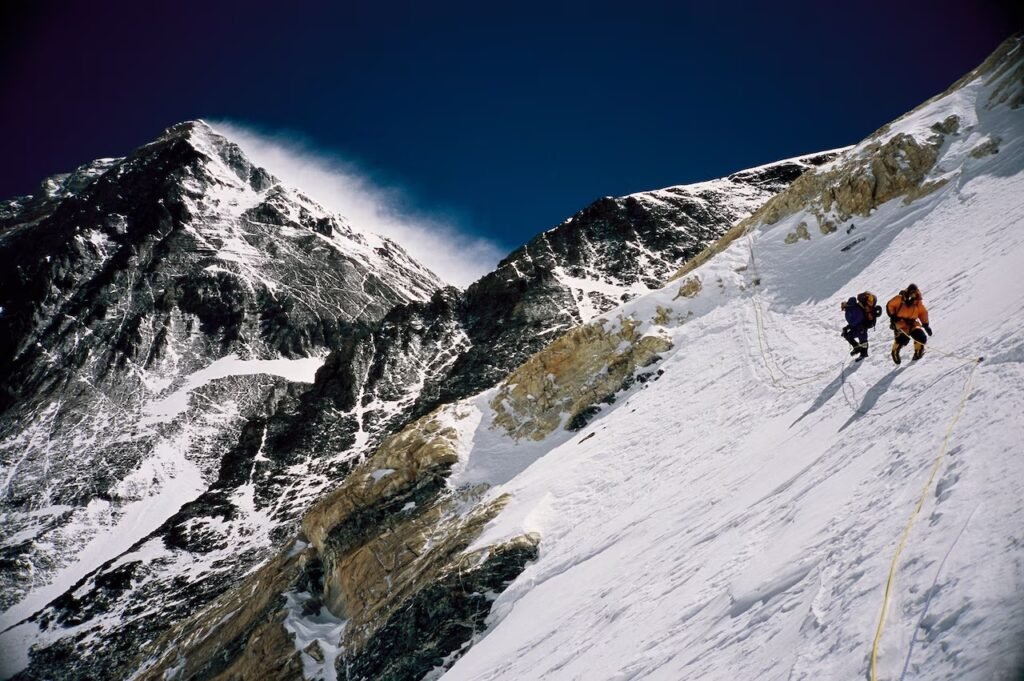Table of Contents
ToggleTop 10 Unknown and Amazing Facts about Mount Everest
The highest mountain in the world, Mount Everest, is located 8,848.86 meters (29,031.7 ft) above sea level. Everest, which is situated in the Himalayas at the boundary between Nepal and China’s Tibet Autonomous Region, has long been associated with human perseverance and ambition.
Ever since it was successfully scaled for the first time in 1953 by Tenzing Norgay, a Sherpa from Nepal, and Sir Edmund Hillary of New Zealand, the mountain has drawn explorers from all over the world. Achieving the summit of Everest is a difficult task that requires navigating dangerous icefalls, tolerating high elevations, and dealing with erratic weather. Even with contemporary technology, it remains one of the most difficult climbs due to the thin air, low oxygen levels, and extreme cold.

As “Goddess of the Sky” and “Mother of the World,” respectively, “Sagarmatha” in Nepali and “Chomolungma” in Tibetan are the local names for Mount Everest. The strong cultural and spiritual significance of the mountain for the indigenous people is reflected in both names.
Every year, hundreds of climbers attempt to reach the top of the world’s tallest peak—Everest—despite the risks involved. However, as overpopulation and waste accumulation have become increasingly pressing issues, the expanding number of climbers has sparked worries about environmental degradation and safety.
1. Mount Everest is Still Growing!
The fact that Mount Everest is still expanding is one of its most amazing features. Yes, the tectonic plate movement is causing the tallest peak in the world to rise in elevation each year. As the Indian and Eurasian tectonic plates clashed around 50–60 million years ago, the Himalayan mountain range, which includes Everest, was created. Because of this continuous tectonic action, the mountain rises by about 4 millimeters (0.16 inches) per year.
Because of the ongoing movement of these plates, Mount Everest is progressively growing in height. This sluggish growth serves to emphasize how dynamic and constantly changing the Earth’s surface is. After collaborative assessments by China and Nepal in 2020, the mountain’s official height was amended to 8,848.86 meters (29,031.7 feet). We might see Everest’s elevation throughout time!
2. Mount Everest is Named After a British Surveyor
Although the mountain is commonly referred to as Mount Everest, its true names, Sagarmatha in Nepali and Chomolungma in Tibetan, mean “Mother of the Universe.” However, British surveyor Sir Andrew Waugh gave it its English name in 1865. Sir George Everest, the Surveyor General of India from 1830 to 1843, was Waugh’s predecessor and the inspiration behind the name of the mountain.
It’s interesting to note that Sir George Everest originally objected to having the mountain named after him, in part because his last name was pronounced differently than most people think it is today (i.e., “Eve-rest,” not “Ever-est”). Nevertheless, the name stayed in spite of his protests, and Mount Everest is now recognized as the highest peak on Earth.
3. The “Death Zone” is Deadly for a Reason
The phrase “death zone,” which refers to altitudes above 8,000 meters (26,247 feet) where the oxygen levels are extremely low, is frequently used to characterize the summit of Mount Everest. Just under one-third of the oxygen present in the air at sea level is found in this zone. Climbers who are oxygen-deficient run a serious danger of developing hypoxia, altitude sickness, and other possibly fatal illnesses.
The human body cannot properly acclimate to such high elevations, and prolonged exposure can cause organ failure and even death. Climbers still suffer from poor judgment, exhaustion, and decreased physical ability even with additional oxygen. Many climbers who die on Mount Everest remain there forever due to the harsh conditions there; it is frequently too risky to try to retrieve their bodies.
4. Mount Everest is Covered in Trash
Every year, hundreds of climbers are drawn to Mount Everest by its attraction, but the excess of expeditions has produced an unfavorable byproduct: trash. Climbers have left behind food wrappers, oxygen cylinders, tents, climbing equipment, and even human feces on the summit over the years. The accumulation of trash on Everest has given it the unwelcome moniker of the “world’s highest garbage dump,” especially in high-traffic locations like Base Camp and the Khumbu Icefall.
There have been initiatives to clean up Everest in recent years. “Everest Clean-up Campaigns” have been conducted by the Nepali government and a number of groups to remove the debris that climbers leave behind. The pristine beauty of Everest is gradually being restored by these efforts, but because of the mountain’s harsh conditions and remote location, it is still very difficult to maintain a clean environment.
5. Over 300 People Have Died on Everest
Since the first reported death on Mount Everest in 1922, more than 300 climbers have lost their life to the summit. Many of these remains are left where they fell due to the severe and brutal conditions on the mountain; they are frozen in time and frequently visible along well-traveled climbing routes. The bodies are preserved by the intense cold and great altitude, making recovery operations exceedingly risky and challenging.
The body of “Green Boots,” a climber whose remains are frequently utilized as a signpost by other climbers ascending the mountain, is arguably one of the most well-known. Though his identity is still unknown, Tsewang Paljor, an Indian climber who died on an expedition in 1996, is believed to be the person who went by the name Green Boots.
The fact that bodies are still on Mount Everest is a sobering reminder of the dangers involved with scaling the highest mountain in the world. Climbers have to make their way past these solemn sites every year as they make their way towards the summit.

6. The History of Everest Summiting
There are many inspiring, tragic, and enigmatic tales from the history of climbing Mount Everest. Although Sir Edmund Hillary of New Zealand and Tenzing Norgay of Nepal made the first successful ascent of the peak on May 29, 1953, the question of whether someone else reached the summit before them is not as well known.
British climbers Andrew Irvine and George Mallory set out to conquer Everest in 1924. The two vanished as they ascended the mountain, and Mallory’s body—which was preserved by the cold—was discovered in 1999. One of the great mysteries of Everest is still whether or not Mallory and Irvine made it to the top before they perished. There’s no solid evidence to support the theory that they may have reached the summit, despite what some people think.
7. The Crucial Role of the Sherpa Community
The Sherpa people, who are native to Nepal’s Himalayan region, are essential in helping climbers reach the top of Mount Everest. Everest missions greatly benefit from the strength, tenacity, and endurance of Sherpas, who are well-known for these qualities. They assist in ensuring climbers’ safety, set up camps, repair ropes, and transport equipment.
Holding the record for the most successful Everest ascents, Kami Rita Sherpa is one of the most amazing Sherpas. He has made it to the summit an astounding 25 times as of 2021! Many climbers would never reach the summit of the globe without the skill of the Sherpa community, whose contributions are sometimes underestimated.
8. Mount Everest was Once Underwater
Though it may be difficult to imagine, an ancient ocean once covered the summit of Mount Everest. Before Everest reached its present height, millions of years ago, the area that is now the Himalayas was a shallow sea called the Tethys Ocean. The rocks close to Everest’s summit include fossils of marine animals, such as ammonites and other marine invertebrates, which provide insight into the mountain’s underwater history.
These old seabeds were forced upward by the collision of the Indian and Eurasian tectonic plates, resulting in the formation of the majestic peaks that we see today. This collision is what gave rise to the Himalayas. A further level of astonishment surrounds the origin of Mount Everest and its geological past.
9. The Weather on Everest Is Extreme
The weather on Mount Everest is often severe and erratic. The top is one of the windiest spots on Earth, frequently buffeted by winds reaching up to 200 miles per hour (322 km/h). In the winter, temperatures at the top can drop as low as -60°C (-76°F), while they seldom ever climb above freezing during the summer.
The pre-monsoon (April–May) and post-monsoon (September–October) seasons, when the weather is generally consistent, are the ideal times to climb Mount Everest. Climbers must be ready for wind, severe cold, and unexpected storms even during these windows. Unpredictable weather is one of the main obstacles faced by climbers trying to reach the peak of Everest.
10. The Highest Jumping Spider Lives on Everest
The Everest Jumping Spider, Euophrys omnisuperstes, is a rare species of jumping spider that lives atop Mount Everest. This is one of the mountain’s most unexpected facts. These small arachnids are the highest permanently existing organisms on Earth, discovered as high as 6,700 meters (22,000 ft).
The wind-driven insects and other small invertebrates that are carried up the mountain by the wind provide food for the Everest Jumping Spider, which thrives in such harsh environments. Even though they are rarely observed, their existence gives Mount Everest’s biodiversity a fascinating new dimension and shows that life can persist in even the most inhospitable conditions.
Beyond being the tallest mountain in the world, Mount Everest is a location rich in mystery, history, and breathtaking natural beauty. Adventurers, scientists, and nature lovers alike are enthralled with the narrative of Everest, from its geological beginnings to the incredible feats of those who have reached its summit.
Ten lesser-known facts about Mount Everest offer fresh perspectives on the difficulties, attractions, and dangers of the tallest mountain in the world. They also give an insight into the intriguing world of the mountain. For everyone who enjoys the outdoors, history, or climbing, Mount Everest never ceases to inspire and amaze them.

